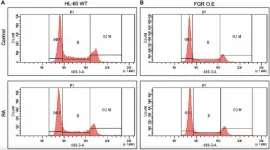When a critically injured patient is admitted to the hospital, how much supplemental oxygen should they receive? New research published this week in JAMA Network Open led by investigators at the University of Colorado School of Medicine suggests it’s often less than the current standard.
“The idea has traditionally been that severe trauma causes stress to patients’ bodies, and we want to deliver as much oxygen as possible to the brain and to vital organs because they are losing blood,” says Adit Ginde, MD, MPH, professor of emergency medicine and lead investigator of the Strategy to Avoid Excessive Oxygen (SAVE-O2) study, which found that targeting slightly lower levels of oxygen saturation, from 90-96%, had similar, and sometimes better, outcomes for adult trauma patients.
“The problem with administering so much oxygen is that the hemoglobin molecules can only carry so much oxygen, and if you oversaturate, you’re unnecessarily delivering excess oxygen to the lungs. That can be potentially harmful, especially when these trauma patients have healthy lungs and little trouble breathing,” he says.
Ginde and fellow collaborators at the CU Center for Combat Medicine and Battlefield (COMBAT) Research say this research, with funding from the U.S. Department of Defense (DoD) to apply to warfighters especially in low-resource environments, could also act as a foundation for improved standards of care for trauma patients across the country.
So far, it’s already taken hold in military health practices.
Normoxemia’s role in trauma recovery
The study took place at eight level 1 trauma centers across the U.S., with the SAVE-O2 research team and enrolling nearly 13,000 patients. The researchers asked whether targeting normoxemia, defined as a peripheral oxygen saturation of 90-96%, could safely increase the number of supplemental oxygen-free days. Patients received only the oxygen they needed – often none at all – to keep them in the normoxemia range.
Researchers found they were able to safely deliver less supplemental oxygen without negatively affecting mortality or time spent in hypoxemia, a lack of oxygen that can harm the body.
“We saw strong evidence that patients did at least as well by being in this normoxemia range. That was good,” Ginde says. “We wanted to then see their clinical outcome, which we measured with supplemental oxygen-free days, a combination of survival and the time spent receiving supplemental oxygen. Overall, we saw a signal for improvement, especially when patients were not on the ventilator. Patients had more days alive and free of supplemental oxygen and spent less time in the hospital, which is a positive sign.”
Patients in the normoxemia range aren’t likely to notice a difference in their breathing compared to those in the highest level of oxygen saturation.
“If your oxygen starts getting low, below 88%, you'll start feeling a shortness of breath, or that you’re working hard to take deeper breaths. But here, we’re targeting physiologically normal ranges, so your body's actually quite content in this range,” Ginde says.
From the battlefield to civilian hospitals
The SAVE O2 work began with a military setting in mind.
“Many combat evacuation missions are planned around when they’ll run out of oxygen,” Ginde says. “Our goal was to determine whether the military could safely provide front line care and evacuate patients with less oxygen.”
To date, there have been updates to 10 relevant Joint Trauma System guidelines and in 2023, Ginde and his research team were awarded Outstanding research Accomplishment at the Military Health System Research Symposium for their advancements in oxygen therapy protocols.
Like much of the work in the CU Center for COMBAT Research, the work is applicable both in and out of military settings.
“We can do the same science that will benefit civilians but also benefit the military. Figuring out how much oxygen is adequate and seeing how we can reduce the amount of supplemental oxygen will benefit the military, but it's also important in civilian and low-resource settings as well,” Ginde says.
The next frontier in oxygen delivery
With the release of these findings, Ginde says that he’s hopeful guidelines will start to evolve and benefit trauma patients across the country.
“Changes tend to take more time on the civilian side. It’s more nebulous than it is with the military, but hopefully, with this high-impact publication and additional presentations, we’ll see these guidelines change over time,” he says.
Now, Ginde and the research team have received additional Department of Defense funding to plan what’s next.
They’re currently testing an autonomous oxygen titration device, called O2Matic, which works via a closed-loop physiologic control that measures oxygen and delivers it to the patient as necessary. A human will no longer have to turn a knob every few hours to adjust oxygen levels. “It’s giving the patient the amount they need – no more, no less,” he explains.
The device has been approved for use in Europe but not yet evaluated in the U.S., so Ginde and his team are leading the registration trial with the U.S. Food and Drug Administration to evaluate the effectiveness of the device at reaching target oxygen saturation.
“This device has the potential to significantly improve how we give oxygen when it’s needed,” Ginde says. “We think this could be the future. Now that we’ve proven the normoxemia target is safe and desirable, the next step is figuring out how to implement it more efficiently and on a broader scale.”
Disclaimer: These efforts were funded by the U.S. Army Medical Research Acquisition Activity through the Congressionally Directed Medical Research Program (W81XWH-20-2-0001) and the U.S. Army Medical Research and Development Command through the Defense Health Agency’s Combat Casualty Care Portfolio and Medical Technology Enterprise Consortium (W81XWH-15-9-0001). The views and conclusions contained herein are those of the authors and should not be interpreted as necessarily representing the official policies or endorsements, either expressed or implied, of the U.S. Government.
END


